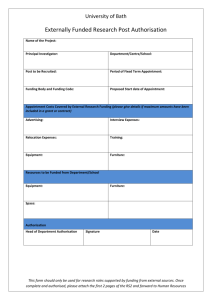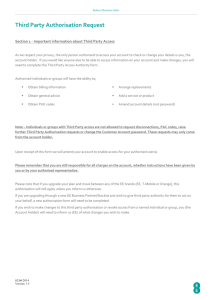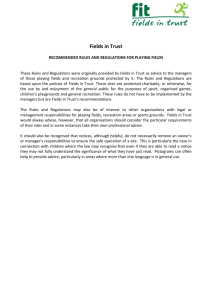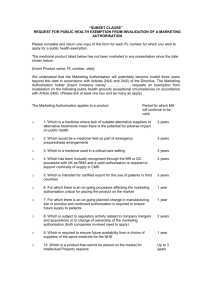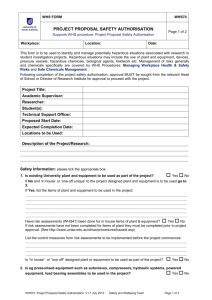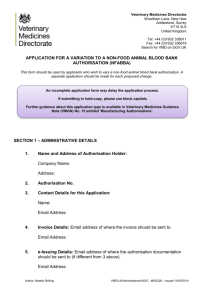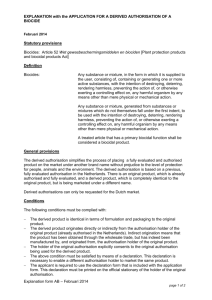Darren Flynn, UK
advertisement
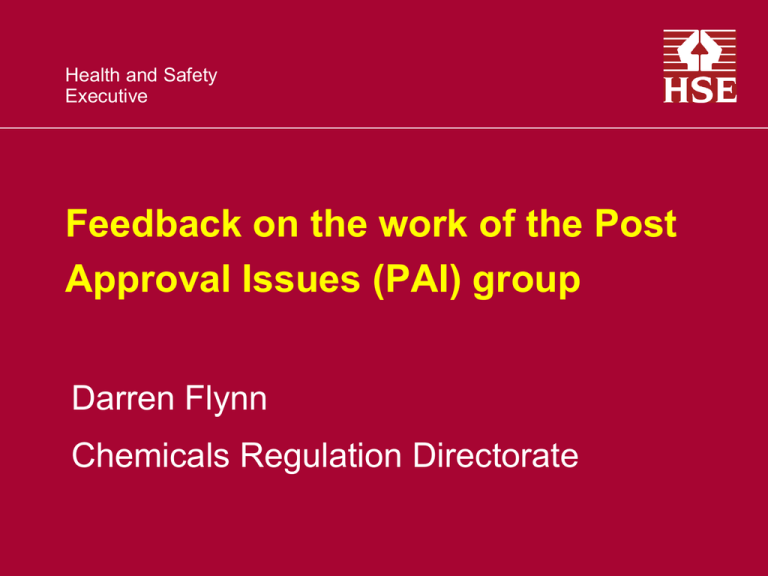
Health and Safety Executive Feedback on the work of the Post Approval Issues (PAI) group Darren Flynn Chemicals Regulation Directorate CRD - who we are and what we do ...... • • • A Directorate of the Health and Safety Executive (HSE) • Regulatory project managers, specialist regulatory scientists = Operational Delivery Team • • Policy team • … and others (me?) 2 locations: York and Bootle 250 staff (approx) – 180 people based in York – 70 people based in Bootle Compliance team Context The primary aim of CRD is: “ to ensure the safe use of biocides, industrial chemicals, pesticides and detergents to protect the health of people and the environment” Chemicals Regulation – ‘under one roof’ • REACH (Registration, Evaluation, Authorisation and Restriction of Chemicals) Regulation. • The Biocidal Products Regulation (BPR) and also ongoing responsibilities under the UK Control of Pesticides Regulations (COPR). • Plant Protection Products Regulation and COPR. • Detergents Regulations. • EU Classification, Labelling and Packaging Regulation. Feedback on the work of the PAI Remit of PAI • PAI; COM Working group established to discuss and develop procedural regulatory issues relating to PPPs, developing regulatory GD where necessary. … not to be confused with • ZSC; to organise work in zone (planning and management of workload) and to develop harmonised risk assessment standards within zone. • IZSC; to organise work across zones (planning and management) and to develop harmonised standards between/across zones. Representatives are for the zone rather than the MS. Feedback on the work of the PAI • Updates on guidance and procedures – Application of guidance – Data protection • Article 43, and data to be evaluated at product renewal • Update on draft Registration Report review Application of guidance • Article 36 Examination for authorisation 1. The Member State examining the application shall make an independent, objective and transparent assessment in the light of current scientific and technical knowledge using guidance documents available at the time of application. It shall give all Member States in the same zone the opportunity to submit comments to be considered in the assessment. Application of guidance • Common interpretation: – Any application for an authorisation submitted under Art 33 has to be assessed in accordance with Art 36 – in the light of current scientific and technical knowledge using the latest guidance documents available at the time of application • Significant problems being experienced with this approach, which is not actually what Article 36 requires: – wasting resource on unnecessary assessments – inequitable treatment of applicants – different conditions and restrictions for identical products Application of guidance • • Example of problems (1): Application for new use – triticale, with product already approved for wheat and barley at same GAP – new risk assessment to latest guidance provided – new assessment failed against the new bird and mammal guidance • Possible outcomes: – triticale refused, but use on wheat and barley continue – ignore the new risk assessment, authorisation granted in line with previous assessment for wheat and barley • CRD risk management decision - issued authorisation, as no additional risk from the new use over and above that already authorised Application of guidance • Example of problems (2): • Application for new generic product – uses identical to those authorised (UP assessment) for the reference product + 60 – new risk assessment to latest guidance provided – new assessment failed against new bird & mammal guidance • Possible outcomes – New generic product refused, even though identical to those already on the market (but no action taken against authorised products) – Ignore the new risk assessment, authorisation granted in line with products already authorised and on the market • CRD risk management decision - issued authorisation, as no additional risk over and above that already authorised for all other products Application of guidance • Example of problems (3): • Application for new generic product – uses identical to those authorised (UP assessment) for the reference product – new risk assessment to latest guidance provided – new aquatic risk assessment requires a larger buffer zone • Possible outcomes – New generic product has larger buffer zone, rendering the product unmarketable – Ignore the new risk assessment, authorisation granted in line with previous assessment for existing product • CRD risk management decision - issued authorisation with same buffer zone as reference product – all products should pick up the larger buffer zone at the same time Application of guidance • Last 2 examples of approach now followed for true generic applicants, in line with GD on applications relying an Article 34: – Latest guidance being used for assessment of equivalence of the active substance and comparability of the formulation. – Applicant relying on unprotected data for the rest of the assessment – often unable to provide an updated risk assessment in line with latest guidance in other areas as they do not have the data – Where equivalent and comparable – no further assessment required - issue authorisation in line with the reference product Application of guidance Ideal solution • Use the latest guidance for the risk assessment associated with the approval or renewal of the active substance. • Then, for the lifetime of the approval of the active substance, apply the same guidance to all products. • New guidance should then be applied at the next review of the active and the products. • Heard the arguments relating to ‘freezing’ science for 7 – 15 years etc, but that is what happens for the active substance! Application of guidance • Already agreed that certain types of application do not involve any technical assessment – purely administrative applications • Still applications for new authorisations, being submitted under Article 33, but latest guidance not being applied – – – – Change in packaging size and material; Change of the name of the authorised products; Change of authorisation holder or marketing company. Authorisations of the same product by using different trade names / marketing companies (back-to-backs) Application of guidance • Alternative ‘purposive’ interpretation – an assessment using the latest guidance documents is only necessary where a new risk assessment is required to support the authorisation. • If no risk assessment is being undertaken in certain areas, there is nothing to apply the latest guidance to! • Approach now adopted for : – Article 34 generic applications – New uses within the risk envelope already authorised. Data protection • Guidance Document on Data Protection, SANCO/12576/2012 – rev.1.1, 1 February 2013 • Originally a Working Document but subsequently noted as a Guidance Document • Reviewed at PAI in light of specific issues raised by MS: – confirmatory data – clarification of general requirements for attracting data protection – Other minor clarifications Data protection • Confirmatory data – only protected where approval is amended as a result of the data – originally protection for 5 years from the date of the amended approval – now confirmed that the data would be protected for 5 or 10 years from the date of the original approval Data protection • The Regulation specifies that in order to attract protection, the following requirements apply to tests and studies: a) The studies must be necessary to support the authorisation; b) Studies must be performed to Good Laboratory Practices/Good Experimental Practices (GLP/GEP) standards; c) The applicant must claim protection for the studies; d) The studies must not have been protected previously (or be subsequently unprotected) in the MS where the authorisation is sought. – b) should be determined by the RMS/ZRMS (for the approval and zonal assessments respectively), and reflected in the lists of studies produced in accordance with Article 60 of the Regulation. – a), c) and d) must be specified by the applicant in their approval and authorisation submissions. The applicant must also identify vertebrate studies. Data required for Article 43 product renewals • Art 43 2 requires only: – Copy of authorisation – new information required as a result of amendments in data requirements or criteria – information that the product meets the requirements of the renewal regulation (i.e. any new specific provisions of renewal of approval limiting use) – a report on monitoring Data required for Article 43 product renewals • In summary, Art 43 2 allows us to consider only the following: – Any new data submitted to meet the new data requirements • Only these data (if relevant) should then be taken forward in a risk assessment to modern guidance • No new data requirements in a particular specialist area = no need for a new risk assessment (echoing principles of Art 34) – any restrictions with respect to the uses specified in the renewed approval (e.g max doses, field of use - Step 1) Data required for Article 43 product renewals • Any new assessment relevant to an issue identified as an area for ‘MS to pay particular attention to’ in the approval regulation - must be addressed to modern standards • Any monitoring data provided (usually national requirements so national rather than zonal assessment?) • Comparative assessment if required Data gaps in EFSA conclusions …… … and when to evaluate • Data gaps identified can be split into three subsets: – Confirmatory data specified in Part B of the approval – Data relating to areas of concern listed as issues that member States should pay particular attention to in Part B of the approval document – Art 43 Renewal – Annex II data gaps not listed as confirmatory data Data gaps in EFSA conclusions …… • Text from typical approval – Part B Data gaps in EFSA conclusions …… • Confirmatory data specified in Part B of the approval need to be evaluated – the confirmatory data requirements and a date for submission (from the notifier to COM) is specified in Part B of the approval – details on procedures for assessment are outlined in the SANCO GD on confirmatory data – product assessments should continue without prejudice to the outcome of the assessment of confirmatory data Data gaps in EFSA conclusions …… • Data relating to areas of concern listed as issues that member States should pay particular attention to in Part B of the approval document – for example the EFSA conclusions may state that risk assessments must be undertaken in certain areas. – since these will be undertaken for the product/use anyway, these should perhaps not be considered as EFSA data gaps - rather product requirements to be assessed for the product. Data gaps in EFSA conclusions …… • • Annex II data not gaps not listed as confirmatory data In principle agreed that Annex II data addressing EFSA data gaps should be left to renewal of the active. However: – where the Annex II EFSA data gap has been addressed by the applicant, – and the data relates to ‘an area MS must pay particular attention to in the UP assessment’ ……. then the Annex II data should be evaluated as part of the product assessment, and evaluation recorded in the Registration Report for the product. Registration Report review A diagram of the structure of the revised dRR: Part C Confidential information Part A Risk Management (core) (MS) Part B 0 Part B 1,2,4 Product background, regulatory context and GAP information (core) Identity, physical and chemical properties, further information (core) Part B 3 Part B 5 Part B 6 Efficacy data and information (core) Analytical methods (core) Mammalian toxicology (core) Part B 7 Part B 8 Part B 9 Part B 10 Metabolism and residues (core) Environmental fate (core) Ecotoxicology (core) Relevance of metabolites in GW (core) Registration Report review As with the original dRR, the revised dRR is split into 3 main sections: •Part A –risk management (national) •Part B –data evaluation and risk assessment (core and national addenda) •Part C – confidential information (core) Part B is split further into ‘subject’ sections, and may be further divided into core assessments (to be assessed by the zonal RMS) and national addenda (covering MS specific national requirements). Registration Report review Key changes: • Inclusion of section on comparative assessment in Part A • New Section B.0 – background, regulatory context and GAP information about all intended uses • Re-numbered to align with new data requirements and Guidance documents • An overview on the data gaps should be included in the summary of each section • Summary/conclusion at the beginning of each section including table with cGAP/summary of cGAPs Registration Report review Timeline: • Circulated for comment by 1 February 2015 • Discussion on final version at March PAIG • Revised template to be noted at March SCoPAFF • Overarching Guidance Document on use of the dRR and worked examples also being prepared. Conclusions • Further consideration needed on the application of latest guidance • Art 34 GD establishes the principle that we should only apply latest guidance to new risk assessments • Slight change to the data protection rules for confirmatory information • Process and procedure for Art 43 renewals being finalised • New format for dRRs to be available soon. Thank you for your attention • Further information • E-mail: pesticides&detergents@defra.gsi.gov.uk • Website: www.hse.gov.uk/crd
